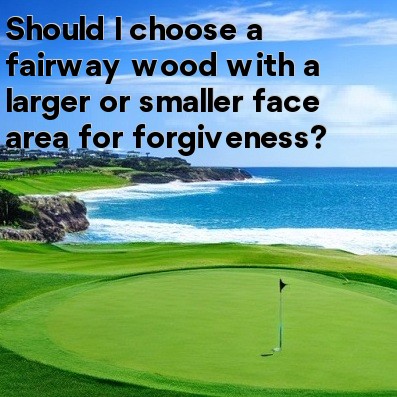
In golf, should I choose a fairway wood with a larger or smaller face area for forgiveness?
Golfers often face the dilemma of choosing between a larger or smaller face area when selecting a fairway wood. The decision ultimately depends on the golfer's individual skill level, swing technique, and personal preferences. Let's delve into the intricacies of forgiveness and how face area plays a role in it.
When it comes to forgiveness in golf, a larger face area generally provides more forgiveness. A larger face increases the sweet spot, which refers to the area on the clubface that delivers the most distance and accuracy when struck correctly. With a larger sweet spot, golfers have a greater margin for error and are more likely to achieve desirable results even on off-center hits.
Furthermore, a larger face area often leads to a higher moment of inertia (MOI). MOI refers to a club's resistance to twisting or rotating upon impact with the golf ball. Clubs with high MOI offer more stability, preventing the clubhead from turning or twisting during the swing. This stability allows golfers to maintain better control and improve accuracy, particularly on mishits.
However, it's important to note that while a larger face area promotes forgiveness, it may also sacrifice some playability. Fairway woods with larger faces tend to have a higher center of gravity (CG), which can affect the ball's launch angle and trajectory. If you struggle with launching the ball high enough or require a particular shot shape, a smaller-faced fairway wood might be more suitable for your game.
For golfers with a higher skill level or a consistent swing technique, a smaller face area might be preferable. These golfers can consistently strike the sweet spot and would benefit from the enhanced workability and control that a smaller face offers. Smaller-faced fairway woods often have a lower CG, promoting a higher launch angle and potentially allowing the golfer to hit the ball farther.
Ultimately, the decision between a larger or smaller face area comes down to personal preference and individual playing style. If forgiveness and playability are your top priorities, a fairway wood with a larger face area will likely be your best bet. On the other hand, if you value workability and enjoy shaping your shots, a smaller-faced fairway wood might suit your game better.
- In conclusion, when choosing a fairway wood, consider factors such as skill level, swing technique, and personal preferences.
- A larger face area provides more forgiveness due to the increased sweet spot and higher MOI.
- However, a larger face area might sacrifice playability and affect the ball's launch angle and trajectory.
- Golfers with consistent swing techniques may prefer a smaller face for enhanced workability and control.
- Ultimately, the decision should be based on personal preference and playing style.
Remember, finding the right fairway wood for your game involves trial and error. It's always recommended to try out different clubs and seek advice from a professional fitter or a golf instructor to ensure you make an informed decision.





